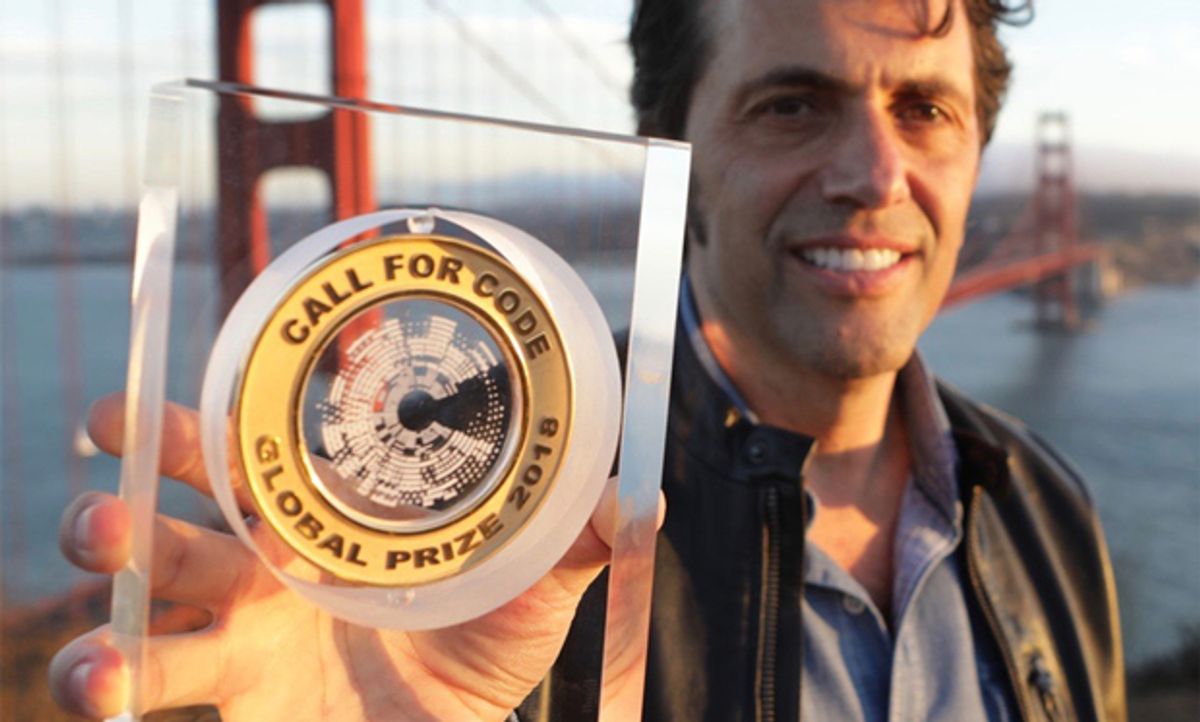On a stormy Tuesday in July, a group of 30 young programmers gathered in New York City to take on natural disasters. The attendees—most of whom were current college students and alumnae of the nonprofit Girls Who Code—had signed up for a six-hour hackathon in the middle of summer break.
Flash floods broke out across the city, but the atmosphere in the conference room remained upbeat. The hackathon was hosted in the downtown office of IBM as one of the final events in this year’s Call for Code challenge, a global competition sponsored by IBM and the Linux Foundation. The challenge focuses on using technology to assist survivors of catastrophes including tropical storms, fires, and earthquakes.
Recent satellite hackathon events in the 2019 competition have recruited developers in Cairo to address Egypt’s national water shortage; in Paris to brainstorm AI solutions for rebuilding the Notre Dame cathedral; and in Bayamón, Puerto Rico, to improve resilience in the face of future hurricanes.
Those whose proposals follow Call for Code’s guidelines are encouraged to submit to the annual international contest for a chance to win IBM membership and Linux tech support, meetings with potential mentors and investors, and a cash prize of US $200,000. But anyone who attends one of these optional satellite events also earns another reward: the chance to poke around inside the most prized software of the Call for Code program’s corporate partners.

In the IBM office, attendees were guided through a four-stage development process by Roger Osorio, a program leader in developer advocacy. During phase two, or “Brainstorming,” teams held rapid-fire idea sessions around the conference room, surrounded by rolling whiteboards and computer chargers crisscrossing piles of Fjällraven backpacks.
At one table, four programmers pored over IBM’s Watson AI platform as they discussed the emergency post-flood communication app they wanted to build. Jailene Rodriguez, a Spanish major and rising college junior, recalled reading a study that people with disabilities and ongoing health issues are especially vulnerable when extreme weather hits.
Megan Mehta, a sophomore, added that the flood warnings she receives by text when the waters rise in her neighborhood would mean little to people who don’t usually rely on their phones to get more information. “Elderly people might not react the way we do to those blunt warnings. They might not know what to do next,” she observed.
That’s where a Watson-powered chatbot would come in, the group decided: by offering people a way to communicate with their devices using natural language, the team hoped to cater to the needs of a broader range of disaster survivors.
Nearby, Watson product manager Sabtain Khan listened to another team describe an issue with their hardware integration plan. The team’s idea, barely two hours old, was to design a kind of wristband with an ID signature that would be activated when an emergency drone was nearby; the activation would alert rescue workers to the locations of survivors. But now the group was split on whether the wristband purchase might be a barrier to participating in the program.
“People didn’t believe Hurricane Sandy would happen. Why would they buy new hardware in advance of a storm?” asked sophomore Bhavika Teli. Khan, who specializes in Watson’s visual processing functions, nodded, posing questions about the group’s target users (parents of young children) and deployment plan (a long-term public information campaign to promote the app). “Have you guys thought about the journey users are taking?” asked Khan.
The wristband project, later dubbed “Find My Child,” was inspired by the winner of the 2018 Call for Code Challenge. Project OWL, whose team members met at a satellite hackathon, won first prize over some 2,500 apps submitted by more than 100,000 developers representing 156 countries. The Project OWL team designed an incident management system that’s still in use in Puerto Rico. Their system consists of an app, a centralized dashboard, and a fleet of waterproof IoT hubs the size of tennis balls.

The “Find My Child” group planned to take advantage of the distributed network created by OWL’s hubs across Puerto Rico to connect wristband-wearers to their parents’ phones. Then, parents could either mark a child ‘paired’ with a guardian or request additional help.
Ultimately, though, the winner of the NYC satellite event was Krisis, whose leaders proposed using AI to analyze map data from drones in a flooded area using signals from the Project OWL emergency network. The winning team—which received its own drones as part of its prize—presented a plan in three stages, starting with flood mapping and ending with a text-to-speech function to help users request specific emergency items to be delivered by drone from rescue centers.
Addressing the world’s most urgent needs is the point of the challenge, says Daniel Krook, chief technology officer of Call for Code and an IBM full-stack developer. Organizers begin every hackathon by introducing themed “starter kits,” which orient teams to the problems they’ll try to solve. Themes are chosen by developers from IBM, Linux, and other tech partners in conjunction with various human rights organizations and UN offices; experts look for problems “with an obvious potential for technical solutions,” but no clear leading approach, says Krook.
“A lot of developers see problems on the news, and they see the impact on their families and people around the world,” Krook said. “At the end of a hackathon, you’ve broken down the barrier of entry to using their skills to addressing real problems they hear about.”
The 2019 Call for Code challenge closed on 29 July. Winners will be announced in the next few months.
This story was updated on 31 July 2019.


